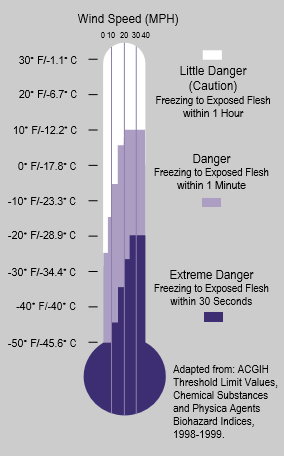Punxsutawney Phil saw his shadow on Groundhog’s Day and says we’re going to have another six weeks of winter! That means many can expect cold weather through February and into March. How much of this cold can we really handle?
In terms of safety, there are limits to how much cold a person can handle at any given time. While it may vary slightly from person to person, the general rule of thumb is 15 minutes inside for every hour spent outside working in the cold to prevent cold stress like hypothermia, frost bite, trench foot, chilblains, and angina. As the temperature drops, however, these time frames need to change to prevent cold stresses.
Outside workers should consider three key factors of temperature, wind, and moisture when determining how much time outside is safe. OSHA and NIOSH have both created Cold Stress Equation guides to reference for more details in terms of temperature, wind, and safe time frames to be outside.
Learn more about cold stress, cold stress symptoms, and how cold is too cold by listening to Kevin King on People’s Law Talk.
For more information on cold stress and safety, review these articles:
- Ferguson, Alan. (2017). Out in the Cold. Safety + Health. Available from: http://www.safetyandhealthmagazine.com/articles/16353-out-in-the-cold
- Anttonen, H., A. Pekkarinen, et al. (2009). “Safety at work in cold environments and prevention of cold stress.” Ind Health 47(3): 254-261. Available from: https://pdfs.semanticscholar.org/16b4/2c4f0d0d98f71f469bc94672b2cea6c47342.pdf
- Chalupka, S. (2009). “Cold stress in the work environment.” AAOHN J 57(1): 40. Available from: http://journals.sagepub.com/doi/pdf/10.3928/08910162-20090101-06
- Holmer, I., K. C. Parsons, et al. (2009). “Cold stress at work: preventive research.” Ind Health 47(3): 205-206. Available from: https://www.jstage.jst.go.jp/article/indhealth/47/3/47_3_205/_pdf/-char/en
- Holmer, I. (2009). “Evaluation of cold workplaces: an overview of standards for assessment of cold stress.” Ind Health47(3): 228-234. Available from: https://www.jstage.jst.go.jp/article/indhealth/47/3/47_3_228/_pdf/-char/en
- Makinen, T. M., J. Jokelainen, et al. (2009). “Occurrence of frostbite in the general population–work-related and individual factors.” Scand J Work Environ Health 35(5): 384-393. Available from: https://www.researchgate.net/profile/Tiina_Ikaeheimo/publication/26789895_Occurrence_of_frostbite_in_the_general_population_-_Work-related_and_individual_factors/links/0f3175357b307e60f3000000/Occurrence-of-frostbite-in-the-general-population-Work-related-and-individual-factors.pdf
- Elliott, F. (2004). “You’d better watch out. Colder weather moves hypothermia and slip-and-fall prevention to the top of many work sites’ hazards list.” Occup Health Saf 73(11): 76, 78. Available from: https://www.researchgate.net/publication/8153194_You%27d_better_watch_out_Colder_weather_moves_hypothermia_and_slip-and-fall_prevention_to_the_top_of_many_work_sites%27_hazards_list
- Anttonen, H. and H. Virokannas (1994). “Assessment of cold stress in outdoor work.” Arctic Med Res 53(1): 40-48. Available from: https://www.researchgate.net/publication/15150249_Assessment_of_cold_stress_in_outdoor_work
Want to hear more talks from Peter and Kevin King? Tune into WCIS 1010 AM Columbus, IN the first and third Friday of every month for People’s Law Talk.


